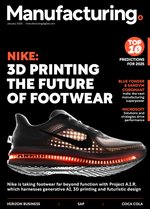Sandvik creates 3D printed diamond composite

Swedish engineering group Sandvik has revealed its creation of a 3D printed diamond composite, opening up a range of new possibilities for the material.
The company says that the composite is perfect for industrial use owing to its hardness, heat conductivity, low density, thermal expansion and corrosion resistance. This is despite differing from synthetic or natural diamonds through being a composite material, with diamond cemented in a very hard matrix material that ensures it is printable while still retaining its diamond-like properties.
“The additive manufacturing process used is highly advanced,” said Mikael Schuisky, Head of R&D and Operations at Sandvik Additive Manufacturing. “We are printing in a slurry consisting of diamond powder and polymer using a method called stereolithography, where complex parts are produced, layer by layer, using ultraviolet light.”
SEE ALSO:
-
Protolabs and GE Additive use 3D printing technologies for Met Gala gowns
-
Markforged accelerates industrial 3D printing ambitions in a new $82mn funding round
Once printed, the diamond composite is not finished. Sandvik credits the proprietary post processing method that occurs after printing with imbuing the composite’s specific properties.
Sandvik’s whole process means that the composite can sidestep some of the issues faced by diamonds, namely the difficulty of shaping the hardest natural material into anything other than simple, geometric shapes. Sandvik say that with its 3D printed composite, complex shapes are now available, opening up a world of possible uses for industry.
“On seeing its potential, we began to wonder what else would be possible from 3D-printing complex shapes in a material that is three times stiffer than steel, with heat conductivity higher than copper, the thermal expansion close to Invar – and with a density close to aluminium,” said Anders Ohlsson, Delivery Manager at Sandvik Additive Manufacturing. “These benefits make us believe that you will see this diamond composite in new advanced industrial applications ranging from wear parts to space programs, in just a few years from now.”

